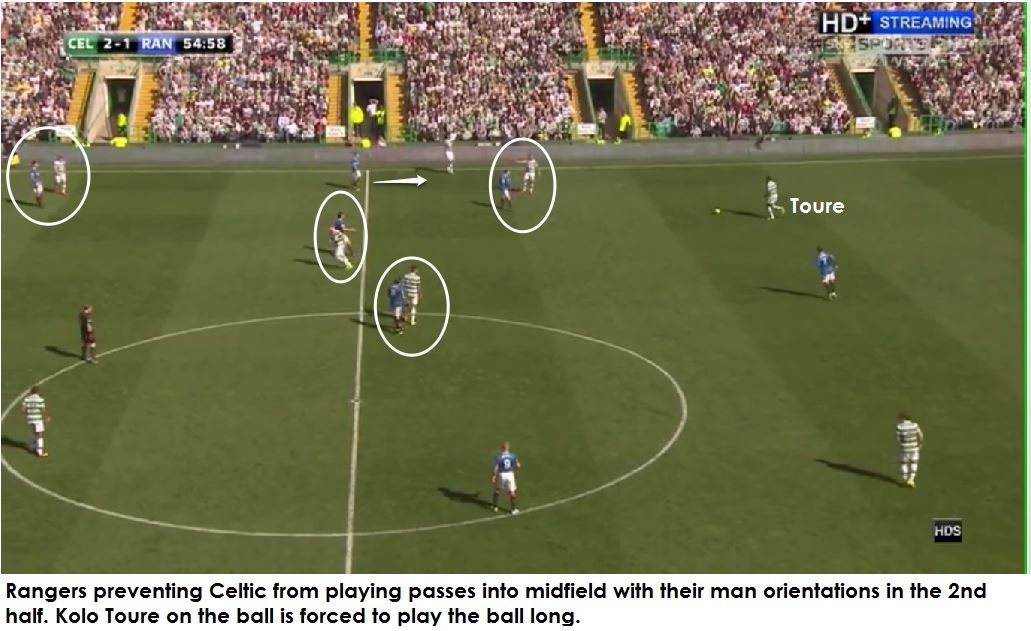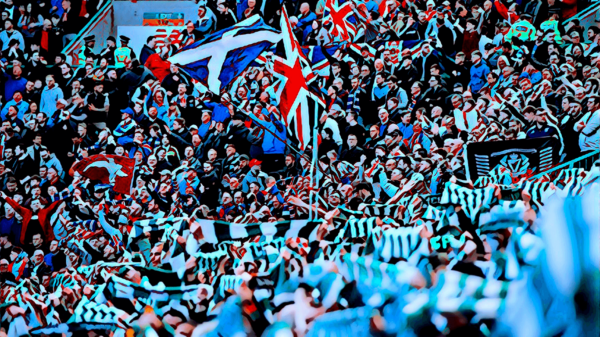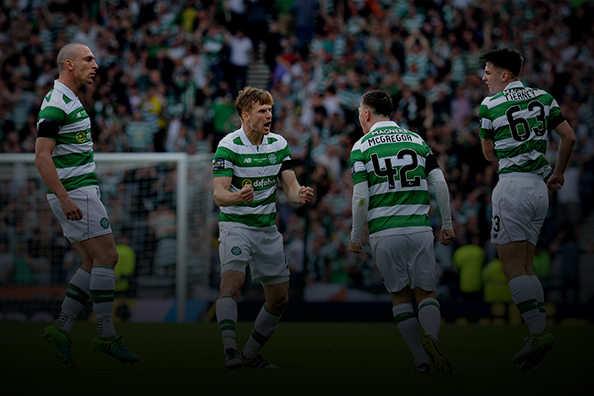Abhijit Bharali writes a detailed tactical analysis of the Old Firm derby that ended Celtic 5-1 Rangers.
Delight for one is despair for the other. The Old Firm derby is back in the Scottish Premiership and Celtic’s delight in a 5–1 win meant despair for Rangers as a Moussa Dembele hat-trick firmly stacked the odds in favour of another title win for the Hoops in the early reckoning.
Line-Ups
Celtic: Dorus de Vries, Mikael Lustig, Kieran Tierney, Kolo Toure, Erik Sviatchenko, Scott Brown (c), Nir Bitton, James Forrest, Tom Rogic, Scott Sinclair, Moussa Dembele.
Rangers: Wes Foderingham, James Tavernier, Lee Wallace (c), Rob Kiernan, Philippe Senderos, Joey Barton, Josh Windass, Niko Kranjcar, Barry McKay, Kenny Miller, Joe Garner.
Basic approach
Celtic lined up in a 4–2–3–1 shape with Brown and Bitton playing as a double-6 in the centre. This allowed Rogic more freedom in his number 10 role which also meant Sinclair could cut inside on occasions. Forrest kept his width on the right throughout given his considerable 1-v-1 prowess and to somewhat negate the threat Rangers posed down their left with Wallace and McKay.
Rangers sat fairly deep, with primary focus on containing Celtic’s greater attacking threat. Their 4–3–3 morphed at times into a 4–5–1 shape off the ball, with Barton and Windass protecting the back line and suffocating any space Rogic had in central areas. Kranjcar would move up from the midfield line on occasions, but McKay was Rangers’ only attacking outlet.
Rangers lacking in attack and early patterns
After the early derby day noise settled down, patterns emerged in the game which saw Rangers sitting back and setting a midfield block that prevented Celtic from building central attacks. That meant the Gers lacked attacking impetus, which was evident as the normally flying Tavernier stayed inside his own half to keep Sinclair in check as opposed to bombing up the right flank.
Rangers’ attacking intent was evident from the way they built up. There was no real purpose in their build-up play as Foderingham’s long goal kicks were easily dealt with by Toure and Sviatchenko, even considering Garner’s aerial prowess. Garner, who played with a partner up front last season at Preston, found himself increasingly isolated as the away side had most of their men back defending.
There were plenty of bad decisions on the ball from Rangers. McKay, wide on the left while the Gers had possession, was the preferred choice of pass even when Tavernier was free on the opposite side. Wallace showed heart but lacked in technique and his underlapping runs were tracked easily with Forrest dropping back.
There was very little in an attacking sense from Rangers, and Tavernier’s less-than-usual offensive involvement was also one of the factors.
Celtic’s attempts to stretch Rangers
Celtic, then, had to figure out ways to bypass Rangers’ five-man midfield block. The onus was on Sinclair and Rogic to create chances, and Rangers made sure Celtic’s two most dangerous players were afforded less space and time with Tavernier on Sinclair and Rogic’s operating area manned by Barton and Windass or Kranjcar.
Celtic tried diagonal switches of play to create 1-v-1 situations in wide areas, Rogic’s ability to needle play in tight spaces, long balls for Dembele running behind the last line, crosses and long shots to bypass Rangers’ mid-block and create chances with varying degrees of success. But a goal from a corner broke the deadlock which once again exposed the Light Blues’ set-piece defending frailties.
Bitton and Brown showed authority in Celtic’s midfield which was in contrast to what the Gers midfield produced. Both Bitton and Brown used their passing range to switch play wide to stretch Rangers. Sinclair tucked inside on occasions, and with Tavernier following him, Miller had mostly a defensive shift in the first half tracking the runs of Tierney.
Rangers defended in a 5-midfield block so Celtic played diagonal switches to bypass it. #SPFL #CELRAN #GlasgowDerby pic.twitter.com/PAQvHFQG4a
— Abhijit Bharali (@blowmeoffaridge) September 12, 2016
Tierney’s overlapping runs were also a tactic to stretch Rangers’ defence. With Sinclair making lateral movements, Celtic tried to crowd the centre with as many men as possible. That meant Miller, who at 36 isn’t the most mobile player around, failed to offer support to Garner up front as he was busy tracking back.
Rangers’ changed dynamics after the opening goal
Celtic’s opener prompted Rangers to push forward more. This inevitably left gaps between defence and midfield which were exploited by the home side to capitalise on a mistake from Kiernan, whose passing was disastrous, for the second goal.
The more open approach from Rangers after the first goal saw Windass and Kranjcar moving further up creating a situational 4-1-4-1 shape when Celtic had the ball inside their own third. Barton moved deeper as Rangers were almost a three at the back with Tavernier and Wallace pushing up.
But the attacking intensity was only temporary as the Gers conceded soon after following Kiernan’s mistake.
Warburton misses Tavernier trick
Another thing that made Rangers a less lethal force going forward was Tavernier staying man oriented with Sinclair throughout the majority of the game. Sinclair came into the game in hot form having scored in the Bhoys’ first three games of the season and the added protection on his side from Rangers was logical, although it basically killed one of their offensive threats in Tavernier.
Tavernier wasn’t seen ahead of Sinclair in the entire first half; he kept his cavalier approach firmly in check.
The fact that Tavernier’s cross created the Rangers goal and his limited forays deep into the Celtic half created promising situations showed how Mark Warburton missed a trick in an attacking sense although he set up his team to contain.
Second half changes from Rangers
Andy Halliday replaced Kranjcar at half-time as Rangers’ late first half goal encouraged them to take greater risks, even at the expense of leaving holes at the back. The midfield maintained a higher line, shadowing Brown and Bitton and in the process cutting off passes to them. While that didn’t directly translate into Rangers becoming a greater attacking threat, Celtic were forced into playing longer balls from the back.
There was also a change in the way Rangers tried to play out from the back in the second half. Foderingham’s distribution was different from the long, straight punts aimed at Garner in the first half; instead he sought the full-backs out wide. That was an idea to progress the ball through triangles from wide areas.
Foderingham spraying balls wide in the 2nd half. Celtic were already on top by then. pic.twitter.com/oFiHguEZSF
— Abhijit Bharali (@blowmeoffaridge) September 12, 2016
Windass and Halliday played higher along their respective half-spaces allowing ball circulation access with the ball receiving full-backs and McKay or Miller further up through triangles. The catch here was that Celtic played a high defensive line, which didn’t allow Rangers to progress the ball the way they would’ve liked to.
Celtic’s high line ensured Bitton and Brown were nearer to Rangers full-backs when Foderingham played his passes, and that allowed the home side to close down the full-backs quickly, thus affecting Rangers’ second half build-ups.
Celtic closing out the game
The third goal basically ended the game as a contest, while Senderos’ sending off allowed Celtic to heap more misery on their rivals with two late goals. Rangers’ second half approach was commendable, although a lack of end product and woeful final third passing and decision-making meant they had nothing to show for their endeavour.
The following snapshot shows how Celtic punished Rangers for being too aggressive in pushing up in the second half. With speedsters like Dembele and Sinclair playing on the shoulders, the gap between the back-line and midfield increased, the direct consequence of which was the third goal.
At 3-1 down, Rangers played without a recognised centre-half following Kiernan’s injury and Senderos’ red card. That meant Barton tucked in alongside Tavernier and Wallace in central defence, further affecting the Gers offensively. Martyn Waghorn and Harry Forrester were desperate last dice throws from Warburton, but they didn’t really matter.
Conclusion
Celtic weren’t very aggressive in their approach; their greater quality ensured they came out on top. Bitton’s composure and conviction on the ball was unmatched and better players across the pitch meant Celtic were always on top. Windass tried to take matters into his own hands with a few piercing runs, but found no team-mates on a similar wavelength.
Josh Windass was a rare bright spark for the Gers. but his runs weren’t much help with less men fwd. #GlasgowDerby pic.twitter.com/4icZ5BtieK
— Abhijit Bharali (@blowmeoffaridge) September 12, 2016
The gulf in technique between the two sides was befitting a game between the champions and a promoted side which it indeed was, even though the derby narrative meant both teams had to start as equals.
The heavy loss puts more pressure on Warburton; the lack of defensive cover and defensive frailties at set-pieces are pressing issues that need to be dealt with. On the other hand, Brendan Rodgers has enjoyed a fine start to life at Paradise. Barcelona await them in the Champions League next; with Dembele and Sinclair in fine form in the absence of Leigh Griffiths and Bitton growing into his role as the orchestrator, the only way is up for the Bhoys.
Read all our other Tactical Analyses here.
- Analysing Belgium’s tactical approach at the 2018 World Cup - June 17, 2018
- Tactical Analysis : Sevilla 0-0 Villarreal: Villarreal’s off-the-ball discipline denies Sevilla - February 8, 2017
- Indian Super League: Indian Team of the Tournament (League Phase) - December 12, 2016






























































